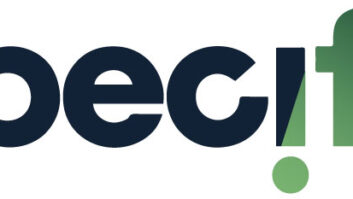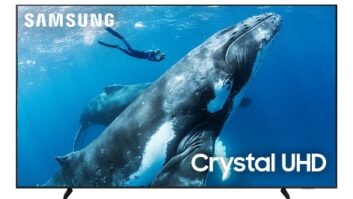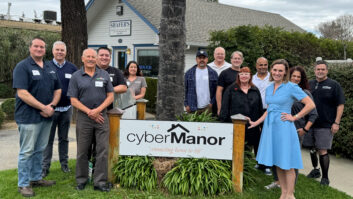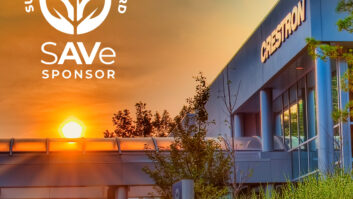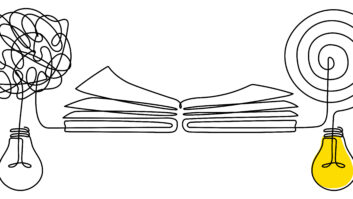Fasten your seat belts, you are about to meet AudioVisions and experience abrupt acceleration. Three-time U.S. national champion cyclist Mark Hoffenberg is accustomed to speed and success. In their first business venture, Hoffenberg, an electrical engineer, and partner Bob Walpert, a mechanical engineer, rode tandem to triumph with a computer-controlled exercise bike venture. Business and patent sold, they geared up next for custom installations, and expanded their management base from two to four with the addition of Ted Taylor and Terence Murray. All four wheels touching pavement, and the business framed by their custom management software, AudioVisions now continues to rack up CEDIA awards, including 1998 Dealer of the Year, 1999 Best Home Theater 75K-150K, 2000 Best Home Theater Level III, 2000 Best Electronic Home Level III and 2000 Best Special Project (Virgin MegaStores).
AudioVisions’ new 20,000 square-foot home office in Lake Forest, California, is appropriately located near a great hill climb and mountain bike trails, and Bob and Mark still take time to ride in the afternoon with the other enthusiasts at the company. In 1998 their Sausalito location opened its doors, and president of Sausalito, Terence Murray, reports that sales already reach the average for CEDIA members. AudioVisions now employs 54 employees and completes 130 projects per year. According to president/CEO Hoffenberg, “Our competitive advantage is that we have a really solid business model, a good management team and great people.”
From Start-up to Industry Icon
“We have grown as a team,” Hoffenberg said of AudioVisions’ development. “I have always had an interest in custom electronics. During high school I sold and installed car stereos, and in college I set up amplifiers and speakers in discos. Bob and I jointly developed the concept for AudioVisions. We first wrote a strong detailed business plan for custom installations. We reviewed the business plan with people in the industry, tweaked it and started into business. I believe in strong planning. You have to think the concept out thoroughly up front.” In 1994 the two company founders were looking to add people, specifically looking to strengthen sales. “Previously we kept running into Ted Taylor, and we thought he would be a great fit, so we acquired his company,” Hoffenberg said. “He knows our products, and people in the industry trust and respect him.” In 1997 the company hired Terence Murray, someone AudioVisions had worked with when he was affiliated with other companies. We were comfortable with this technical and business acumen,” Hoffenberg said. “He is good with people, and he has been inside other businesses and so brings experiences and expanded management insight, which is somewhat rare in this industry as owners manage most companies. Our business plan called for growing our company into a national brand. Terence had strong ties to northern California, so we opened our first new location in Sausalito, and Terence is now president of that operation.”
Software Models Business
Murray attributes the rapid launch of the northern California location with AudioVisions’ custom software. “The software is a key component for engineering into a true best practices model,” he said. “With Proposal Wizard, more than just generating proposals, we can manage the details of the job. In web-based time with can do the costing and schedule, all of which tie into best practices.” Hoffenberg provides an understanding of how and why AudioVisions wrote their own software program. “After being in business for a couple of years, it seemed we were spending an inordinate amount of time to generate a proposal that met our standards for completeness and appearance,” he explained.
“Recognizing that we needed to speed up the process, we developed a mini-application in a spreadsheet program.” A programmer friend of Hoffenberg reviewed the program, and said that he really needed a relational data base application. The friend set to work on it, and in three to four weeks AudioVisions could both automate proposals and maintain a product database. “He continued to develop and refine the program, and we presented the application at the CEDIA conference in 1992,” Hoffenberg said. “It was well received and we got a great deal of encouragement to bring it to market.”
The two became partners in a company called Merlin, which produced the Proposal Wizard software. “Technical support was much more expensive than Merlin anticipated, and we never made any money, but through the process of analyzing our business so closely, the company gained valuable information and vital insights,” Hoffenberg remembered. “We continue to develop and refine the software for our own use, and it is key to managing and growing our business.” Paul Eisenhauer, an AudioVisions project manager, produced a Gantt chart for a job and described how the software program integrates data for all aspects of a project, “We can generate a detailed cost proposal for the client in several hours,” he explained. “After entering the client’s final decisions, we can produce the contract and any change orders. The data is there for ordering equipment, scheduling our personnel, tracking progress and billing the client.”
The Right Place at the Right Time
In addition to smart planning and excellent execution, Hoffenberg thinks AudioVisions is also at the right place and in the right market, at the right time. Taylor, who now holds the vice president of sales title, agrees, “The South Coast is a good market. There is a lot of construction of fine new homes. We can work all year, and the climate allows us to install some elaborate outdoor systems, and occasionally some systems on boats. “The clientele in this business are high-powered people who want a comfortable business relationship, and they want to be taken care of. They don’t want a learning curve for their system. They hire professionals, and demand professional service. When you can meet these high expectations, then they are loyal clients and excellent sources of referrals. Taylor adds that the company’s relationships with builders, architects and designers are similar. “They want us to take care of the installation and to take care of the clients, including walking the client through the learning process. The way installations are progressing, they are becoming highly complex and require coordination with many trades people. The most successful projects result when we are involved early on so that the system installation requirements can be fully integrated into the project schedule.” AudioVisions has four divisions for serving different segments of the market: custom homes, production homes, corporate systems integration and commercial systems. “We work on a good mix of residential and commercial projects,” Taylor offered. “In this market, we have production homes in the range of $2-3 million that demand a structured wiring network to maximize current and future technologies. As you would expect, there is a large variation in custom home services: theaters, distributed audio, multi-line digital phone systems, intercoms, whole-house lighting controls, structured wiring, video surveillance, and centralized vacuums.
Our corporate systems services include multi-media facilities for corporate boardrooms and training rooms where we integrate videoconferencing, audio/video playback, computer presentations, and lighting control into one simplified system. For commercial systems, nationally we have completed 20 Virgin MegaStores, where we were the first to install CD listening stations. In addition to those, we have quite a few projects out-of-state, as well.” Taylor is a long-time audio aficionado who collects analog equipment. He says he never tires of the business. “Every time I think there are limits on the capabilities of a system, we soon exceed them. The only limit appears to be our clients’ desires to explore where these limits may be.”
To Do a Job Better, You Need Better People
According to Walpert, who serves as vice president of operations, professional service is the key to successful operations. “We are on the front edge-always trying to do things better,” he said. “There is an equation, that in order to do a job better, you need better people. We want this to be a good environment for our employees and to always recognize the importance of the work they do. This is the only was to keep doing better.” The office cappuccino bar, ping-pong table, and gym membership program back up the company’s efforts for a good working environment. As for the work itself, Walpert oversees all installations, materials management, project management, finances, engineering and programming. Despite this range of detailed and demanding responsibilities, he wears an amused smile and appears relaxed, popping dryly witty remarks with a quiet delivery. “I’m a mechanical engineer and I like to solve problems,” Walpert said about his job. “I’m fascinated by how things work, and having things work well together.” Walpert sees training, equipment, and the opportunity to grow as essential to attracting and keeping quality people. “We have sent as many as 33 people to CEDIA trainings and the conference,” he said.
“Our Tool and School program provides an open line of credit for education and access to technology. We encourage computer ownership through a lease program with tax-free company contributions. Each employee takes a self-evaluation test to determine their interests and talents as well as their desires for advancement, and the tool clarifies what steps need to be taken for the employee to move ahead. We offer team incentives for our project teams. Through working with the teams, we have also developed and keep updating our Standard Operating Procedures, the Technicians Bible. It is a field resource with all the forms they will need, wire interconnects, and standards for re-wire, trim, and final installations.”
A Slightly Different Market
Murray says that he has noticed market differences between southern and northern California, including a higher price per square foot of property in northern California. “We are looking at custom homes in the range of 12,000 to 20,000 square feet versus the 20,000-plus square feet common in Orange County’s south coast,” he explained. “Also, there is less new construction and more remodels. There is more interest in plasma screens because of the smaller rooms. We service vacation homes in the Napa-Sonoma and Lake Tahoe areas. Customers there are asking for remote monitoring of the home’s vital signs and web cams to visually check on the homes through a browser-based system.”
The Next Challenges
Mark Hoffenberg says that AudioVisions’ biggest challenge lies in its continued growth into new markets, while simultaneously adapting to rapid changes in our industry. “With this in mind, we created a Best Practices Initiative,” he explained. “We began by first creating an alliance with some of the most business-savvy companies in the industry. Our goal with the alliance is to define and implement common operating standards among our businesses, while continuing to refine our scalable business model. The next step is to incorporate these practices into AVIS, our custom business management software. Our software, somewhat of a combination of CRM, ERP and Enterprise Project Management software, is a key component to engineering and implementing a truly scaleable best practices business model. AVIS can support thousands of simultaneous users over a LAN or WAN, operating from a common data file. This architecture, coupled with our scalable business model, provides our infrastructure for national growth.”
So after tuning up his business to run like a high-performance racing bike, does Hoffenberg like his job as much as he likes putting rubber to the road on a sunny California afternoon? “I like the challenge, excitement, technology, and people-there is not just one thing,” he answered. “I love this industry. I would be a great client myself, because I love all this stuff.”


